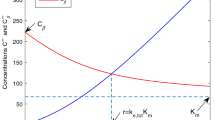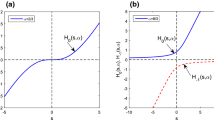Abstract
Clinically, it is known that some disease states respond to drug treatment in a cyclic manner. This has resulted in qualitatively, or empirically, determined cyclically varying drug treatment studies which have been shown to improve therapeutic response in some cases. A theory is developed, for drugs that can be described by pure catenary pharmacokinetic models, which enables one to quantitatively determine at what time a cyclic infusion of drug should be initiated, what the frequency of infusion should be, and what the amplitude of the infusion should be to obtain maximum therapeutic benefit at steady state. Also, the theory allows one to determine quantitatively a priori if a drug's pharmacokinetics precludes the possibility of any real advantage to be gained by cyclically infusing the drug. To implement the theory, it is assumed that the drug obeys linear pharmacokinetics and that the desired pharmacological response is rapid and approximately proportional to a pharmacokinetic compartmental concentration. In particular, a linear system analysis approach is applied to drugs obeying linear pharmacokinetics. It is found that at steady state the amplitude, of the sinusoidally varying component of drug's compartmental concentration can be expressed as the amplitude of the rate of infusion times the magnitude of the compartment's transfer function. In addition, an expression for the shift in phase (lag time) of the compartmental drug concentration, relative to the input infusion, is obtained. For a one-compartment model, or for a compartment containing the site of infusion, the amplitude of the sinusoidally varying component ultimately declines in direct proportion to the period (T) of oscillation and the lag time increases from 0 to −0.25T as the period decreases. At a short enough cyclic infusion period, the lag time increments by an additional value of −0.25T, and the attenuation in sinusoidal amplitude decreases by an additional factor of T, for each compartment sequentially connected down the chain from the compartment receiving the infusion. This theory is then applied to the drugs, 5- fluorouracil, KS1/4- DAVLB, theophylline, and adriamycin to see if sinusoidal modulation of the infusion rate would be of therapeutic benefit. The theoretical predictions are then compared to clinically determined empirical results and shown to be consistent. In general, it is shown that the micro rate constants describing the drug's pharmacokinetics must be large (i.e., the system must be able to respond rapidly) for sinusoidal infusion to be of value.
Similar content being viewed by others
References
A. Reinberg (ed.).Clinical Chronopharmacology: Concepts, Kinetics, Application, Hemisphere, New York, 1990.
J. Arendt, D. S. Minors, and J. M. Waterhouse (eds.).Biological Rhythms in Clinical Practice, Wright, London, 1989.
C. Focan. Sequential chemotherapy and circadian rhythm in solid tumors-A randomized trial.Cancer Chemother. Pharmacol. 3:197–202 (1979).
W. J. M. Hrushesky. Circadian timing of cancer chemotherapy.Science 228:73–75 (1985).
M. H. Smolensky. Clinical chronopharmacology-bronchodilators with special reference to sustained-release theophylline. In A. Reinberg (ed.),Clinical Chronopharmacology: Concepts, Kinetics, Application, Hemisphere, New York, 1990, pp. 119–176.
E. Haus, F. Halberg, J. E. Pauly, S. Cardoso, J. F. W. Kuhl, R. B. Sothern, R. N. Shiotsuka, and D. S. Hwang. Increased tolerance of leukemic mice to arabinosyl cytosine with schedule adjusted to circadian system.Science 177:80–82 (1972).
L. E. Scheving, E. Haus, J. F. W. Kuhl, J. E. Pauly, F. Halberg, and S. Cardoso. Close reproduction of different laboratories of characteristics of circadian rhythm in 1-β-D-arabinofuranosylcytosine tolerance by mice.Cancer Res. 36:1133–1137 (1976).
F. Levi, F. Halberg, M. Nesbit, E. Haus, and H.Levine. Chronooncology. In H. E. Kaiser (ed.),Neoplasms-Comparative Pathology of Growth in Animals, Plants, and Man, Willims and Wilkins, Baltimore.
R. V. Roemeling and W. J. M. Hrushesky. Circadian pattern of continuous FDUR infusion reduces toxicities. InAdvances in Chronobiology Part B. Proceedings of the XVIIth International Conference of the International Society for Chronobiology, Alan R. Liss, New York, 1987, pp. 357–373.
J. P. Caussanel, F. Levi, J. L. Misset, A. Descorps Declere, R. Adam, H. Bismuth, A. Reinberg, and G. Mathe. Chronotherapy of patients with metastatic colorectal cancer with 5-fluorouracil (5-FU) and Oxaliplatin (1-OHP), automatically delivered via a programmable external pump. Preliminary results. In A. Reinberg, M. Smolensky, and G. Labrecque (eds.),Annual Review of Chronopharmacology, Vol. 5, Pergamon, New York, 1988, pp. 403–406.
M. E. Van Valkenberg.Network Analysis, 2nd ed., Prentice-Hall, Englewood Cliffs, NJ, 1964, pp. 322–323.
C. L. Phillips and R. D. Harbor.Feedback Control Systems, Prentice-Hall, Englewood Cliffs, NJ, 1988, pp. 32–35.
D. J. Cutler. Linear systems analysis in pharmacokinetics.J. Pharmacokin. Biopharm,6:265–282 (1978).
M. E. Van Valkenberg.Network Analysis, 2nd ed., Prentice-Hall, Englewood Cliffs, NJ, 1964, pp. 159–187.
B. P. Lathi.Signals, Systems and Communication, Wiley, New York, 1965, pp. 1–43.
L. Z. Benet. General treatment of linear mammillary models with elimination from any compartment as used in pharmacokinetics.J. Pharm. Sci. 61:536–541 (1972).
E. Kreyszig.Advanced Engineering Mathematics, 2nd ed., Wiley, New York, 1967, pp. 204–208.
E. Kreyszig.Advanced Engineering Mathematics, 2nd ed., Wiley, New York, 1967, p. 22.
G. B. Thomas and R. L. Finney.Calculus and Analytic Geometry, Addison-Wesley, Reading, MA, 1988, pp. 713–714.
P. G. Welling.Pharmacokinetics Processes and Mathematics, ACS Monograph 185, American Chemical Society, Washington, DC, 1986, p. 223.
M. Rowland and T. N. Tozer.Clinical Pharmacokinetics Concepts and Applications, Lea and Febiger, Philadelphia, PA, 1989, p. 71.
J. G. Wagner.Fundamentals of Clinical Pharmacokinetics. Drug Intelligence Publications, Hamilton, Illinois, 1975, pp. 90–94.
J. M. Collins, R. L. Dedrick, F. G. King, J. L. Speyer, and C. E. Myers. Nonlinear pharmacokinetic models for 5-fluorouracil in man: Intravenous and intraperitoneal routes.Clin. Pharmacol. Ther. 28:235–246 (1980).
D. Schneck, F. Butler, W. Dugan, D. Littrell, B. Petersen, R. Bowsher, A. DeLong, and S. Dorrbecker. Disposition of murine monoclonal antibody vinca conjugate (KS1/ 4-DAVLB) in patients with adenocarcinomas.Clin. Pharmacol. Ther. 47:36–41 (1990).
P. A. Mitenko and R. I. Ogilvie. Pharmacokinetics of intravenous theophylline.Clin. Pharmacol. Ther. 14:509–513 (1973).
R. F. Greene, J. M. Collins, J. F. Jenkins, J. L. Speyer, and C. E. Myers. Plasma Pharmacokinetics of adriamycin and adriamycin and adriamycinol: Implications in the design of in vitro experiments and treatment protocols.Cancer Res. 43:3417–3421 (1983).
P. A. J. Speth, P. C. M. Linssen, R. S. G. Holdrinet, and C. Haanen. Plasma and cellular adriamycin concentrations in patients with myeloma treated with a ninety-six hour continuous infusion.Clin. Pharmacol. Ther. 41:661–665 (1987).
P. Calabresi and B. R. Chabner. Antineoplastic agents. In A. G. Gilman, T. W. Rall, A. S. Nies, and G. Taylor (eds.),Goodman and Gilman's The Pharmacological Basis of Therapeutics, Pergamon, New York, 1990, pp. 1202–1263.
C. P. Spears, A. H. Shanhinian, R. G. Moran, C. Heideberger, and T. H. Corbett. In vivo kinetics of thymidylate synthetase inhibition in 5-fluorouracil sensitive and resistant murine colon adenocarcinomas.Cancer Res. 42:450–456 (1982).
G. J. Peters, J. V. Diijk, J. C. Nadall, C. J. V. Groeningen, J. Lankelma, and H. M. Pinedo. Diurnal variation in the therapeutic efficacy of 5-fluorouracil against murine colon cancer.In Vivo 1:113–118 (1987).
P. A. Mitenko and R. I. Ogilvie. Rational intravenous doses of theophylline.New Engl. J. Med. 289:600–603 (1973).
P. A. J. Speth, Q. G. C. M. van Hoesel, and C. Haanen. Clinical pharmacokinetics of doxorubicin.Clin. Pharmacokin. 15:15–31 (1988).
L. Z. Benet and R. L. Williams. Appendix II-Design and optimization of dosage regimens: Pharmacokinetic data. In A. G. Gilman, T. W. Rall, A. S. Nies, and P. Taylor (eds.),Goodman and Gilman's The Pharmacological Basis of Therapeutics, Pergamon, New York, 1990, pp. 1650–1735.
M. Rowland and T. N. Tozer.Clinical Pharmacokinetics Concepts and Applications, 2nd ed., Lea and Febiger, Philadelphia, PA, 1989, pp. 113–130.
G. Levy. Chronotherapeutics pharmacokinetic constraints and opportunities. InTemporal Control of Drug Delivery, Ann. N.Y. Acad. Sci. 618:116–122 (1991).
F. Theeuwes and W. Bayne. Controlled-release dosage form design. In J. Urquhart (eds.),Controlled-Release Pharmaceuticals, American Pharmaceutical Association, Academy of Pharmaceutical Sciences, Washington, D.C., 1981, pp. 61–93.
Author information
Authors and Affiliations
Rights and permissions
About this article
Cite this article
Burnette, R.R. Fundamental pharmacokinetic limits on the utility of using a sinusoidal drug delivery system to enhance therapy. Journal of Pharmacokinetics and Biopharmaceutics 20, 477–500 (1992). https://doi.org/10.1007/BF01061467
Received:
Revised:
Published:
Issue Date:
DOI: https://doi.org/10.1007/BF01061467




